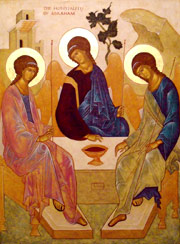Home
An Introduction to Wellspring
*

Orthodox Christianity, most widely known as “Eastern Orthodoxy,” is an inexhaustible wellspring of beauty, truth and life. From its earliest form at the time of Jesus’ apostles through centuries of elaborate development in liturgy and doctrine, that wellspring has focused above all on adoration of the triune God: Father, Son and Holy Spirit united in the one Godhead.1 As Fr Alexander Schmemann so often stressed, the human person is before all else homo adorans, one who worships the God of love and boundless compassion. Created in God’s “image” and called to achieve His “likeness,” we have only one ultimate purpose and source of meaning in our existence. That is, by our worship as by our works of love, to follow the pathway of beauty and truth through this life and into Life beyond.
For several decades I had the privilege of teaching Orthodox seminarians and lay people in theological institutions in France, Romania and the United States. It was a marvelous and humbling experience. More often than not I came away from class or from an informal discussion with fresh insight into the meaning of a biblical passage or the complexity of a moral dilemma. As so often happens in the teaching profession, I learned far more from my students than I was ever able to convey to them. That, though, is the way it should be. A teacher can be little more than a catalyst. This is especially true in schools of theology. If students are to discover the beauty and truth of authentic Christian life, they must do so on their own. They, like all of us, need to be guided by others – by the Holy Spirit, by Church Tradition, and by the occasional teacher. Yet in the end, they can grow in spiritual maturity only through their own personal encounter with the living Christ.
It’s this concern to act as something of a catalyst that has shaped the various books and articles I have written over the past forty years. The rubrics at the top of this page indicate the several fields in which I am particularly interested, beginning with biblical and ethical subjects, and coming finally to questions arising from the convergence of science (especially quantum theory and cosmology) and Christian faith. It seems rather presumptuous to post these writings on a webpage. If I do so, it’s with the hope that some of the thinking I’ve been prompted to do by students, colleagues and others will be of interest and use to other people.
This site, then, is a form of archive. May it serve in some modest way to encourage readers to seek the ultimate Wellspring, which is the source of our hope and joy, and the object of our deepest longing.
Fr. John Breck
- The homepage icon is a rendering by Heather MacKean of a well-known image produced by the 15th century monk, St André Rublev. The underlying theme is the meeting of Abraham, Sarah and the three angels at the Oak of Mamre (Genesis 18) and is known by the Greek term “Philoxenia,” or “welcome of strangers.” In Rublev’s version, the scene has been projected onto the heavenly plane, and the figures are symbolic representations of the Holy Trinity. ↩︎